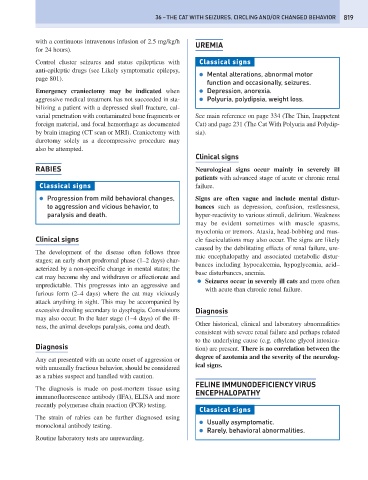Page 827 - Problem-Based Feline Medicine
P. 827
36 – THE CAT WITH SEIZURES, CIRCLING AND/OR CHANGED BEHAVIOR 819
with a continuous intravenous infusion of 2.5 mg/kg/h
UREMIA
for 24 hours).
Control cluster seizures and status epilepticus with Classical signs
anti-epileptic drugs (see Likely symptomatic epilepsy,
● Mental alterations, abnormal motor
page 801).
function and occasionally, seizures.
Emergency craniectomy may be indicated when ● Depression, anorexia.
aggressive medical treatment has not succeeded in sta- ● Polyuria, polydipsia, weight loss.
bilizing a patient with a depressed skull fracture, cal-
varial penetration with contaminated bone fragments or See main reference on page 334 (The Thin, Inappetent
foreign material, and focal hemorrhage as documented Cat) and page 231 (The Cat With Polyuria and Polydip-
by brain imaging (CT scan or MRI). Craniectomy with sia).
durotomy solely as a decompressive procedure may
also be attempted.
Clinical signs
RABIES Neurological signs occur mainly in severely ill
patients with advanced stage of acute or chronic renal
Classical signs failure.
● Progression from mild behavioral changes, Signs are often vague and include mental distur-
to aggression and vicious behavior, to bances such as depression, confusion, restlessness,
paralysis and death. hyper-reactivity to various stimuli, delirium. Weakness
may be evident sometimes with muscle spasms,
myoclonia or tremors. Ataxia, head-bobbing and mus-
Clinical signs cle fasciculations may also occur. The signs are likely
caused by the debilitating effects of renal failure, ure-
The development of the disease often follows three
mic encephalopathy and associated metabolic distur-
stages; an early short prodromal phase (1–2 days) char-
bances including hypocalcemia, hypoglycemia, acid–
acterized by a non-specific change in mental status; the
base disturbances, anemia.
cat may become shy and withdrawn or affectionate and
● Seizures occur in severely ill cats and more often
unpredictable. This progresses into an aggressive and
with acute than chronic renal failure.
furious form (2–4 days) where the cat may viciously
attack anything in sight. This may be accompanied by
excessive drooling secondary to dysphagia. Convulsions Diagnosis
may also occur. In the later stage (1–4 days) of the ill-
Other historical, clinical and laboratory abnormalities
ness, the animal develops paralysis, coma and death.
consistent with severe renal failure and perhaps related
to the underlying cause (e.g. ethylene glycol intoxica-
Diagnosis tion) are present. There is no correlation between the
degree of azotemia and the severity of the neurolog-
Any cat presented with an acute onset of aggression or
ical signs.
with unusually fractious behavior, should be considered
as a rabies suspect and handled with caution.
FELINE IMMUNODEFICIENCY VIRUS
The diagnosis is made on post-mortem tissue using
ENCEPHALOPATHY
immunofluorescence antibody (IFA), ELISA and more
recently polymerase chain reaction (PCR) testing.
Classical signs
The strain of rabies can be further diagnosed using
● Usually asymptomatic.
monoclonal antibody testing.
● Rarely, behavioral abnormalities.
Routine laboratory tests are unrewarding.

